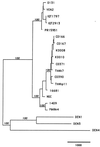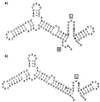Dengue virus structural differences that correlate with pathogenesis
- PMID: 10233934
- PMCID: PMC112516
- DOI: 10.1128/JVI.73.6.4738-4747.1999
Dengue virus structural differences that correlate with pathogenesis
Abstract
The understanding of dengue virus pathogenesis has been hampered by the lack of in vitro and in vivo models of disease. The study of viral factors involved in the production of severe dengue, dengue hemorrhagic fever (DHF), versus the more common dengue fever (DF), have been limited to indirect clinical and epidemiologic associations. In an effort to identify viral determinants of DHF, we have developed a method for comparing dengue type 2 genomes (reverse transcriptase PCR in six fragments) directly from patient plasma. Samples for comparison were selected from two previously described dengue type 2 genotypes which had been shown to be the cause of DF or DHF. When full genome sequences of 11 dengue viruses were analyzed, several structural differences were seen consistently between those associated with DF only and those with the potential to cause DHF: a total of six encoded amino acid charge differences were seen in the prM, E, NS4b, and NS5 genes, while sequence differences observed within the 5' nontranslated region (NTR) and 3' NTR were predicted to change RNA secondary structures. We hypothesize that the primary determinants of DHF reside in (i) amino acid 390 of the E protein, which purportedly alters virion binding to host cells; (ii) in the downstream loop (nucleotides 68 to 80) of the 5' NTR, which may be involved in translation initiation; and (iii) in the upstream 300 nucleotides of the 3' NTR, which may regulate viral replication via the formation of replicative intermediates. The significance of four amino acid differences in the nonstructural proteins NS4b and NS5, a presumed transport protein and the viral RNA polymerase, respectively, remains unknown. This new approach to the study of dengue virus genome differences should better reflect the true composition of viral RNA populations in the natural host and permit their association with pathogenesis.
Figures




References
-
- Berzofsky J A. Intrinsic and extrinsic factors in protein antigenic structure. Science. 1985;229:932–940. - PubMed
-
- Blok J, Gibbs A J, McWilliam S M, Vitarana U T. NS1 gene sequences from eight dengue-2 viruses and their evolutionary relationships with other dengue-2 viruses. Arch Virol. 1991;118:209–223. - PubMed
-
- Bray M, Lai C-J. Dengue virus premembrane and membrane proteins elicit a protective immune response. Virology. 1991;185:505–508. - PubMed
-
- Brinton M A, Dispoto J H. Sequence and secondary structure analysis of the 5′-terminal region of flavivirus genome RNA. Virology. 1988;162:290–299. - PubMed
Publication types
MeSH terms
Substances
Associated data
- Actions
- Actions
- Actions
- Actions
- Actions
- Actions
- Actions
- Actions
- Actions
- Actions
- Actions
- Actions
- Actions
- Actions
- Actions
- Actions
- Actions
- Actions
- Actions
Grants and funding
LinkOut - more resources
Full Text Sources
Other Literature Sources
Molecular Biology Databases
Research Materials
Miscellaneous

